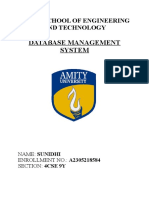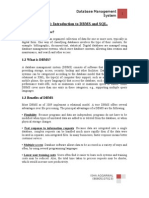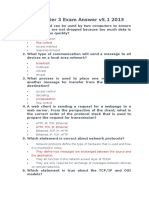0 ratings0% found this document useful (0 votes)
44 viewsIntroduction To SQL
Uploaded by
SEBELLO Lawrence VergaraCopyright
© © All Rights Reserved
We take content rights seriously. If you suspect this is your content, claim it here.
Available Formats
Download as PDF, TXT or read online on Scribd
0 ratings0% found this document useful (0 votes)
44 viewsIntroduction To SQL
Uploaded by
SEBELLO Lawrence VergaraCopyright
© © All Rights Reserved
We take content rights seriously. If you suspect this is your content, claim it here.
Available Formats
Download as PDF, TXT or read online on Scribd
You are on page 1/ 17
INTRODUCTION TO SQL
BY: MAILA JERRIELYN D. CALIAO
OBJECTIVES
Define terms
Interpret history and role of SQL
Define a database using SQL data definition
language
SQL OVERVIEW
Structured Query Language
The standard for relational database management systems
(RDBMS)
RDBMS: A database management system that manages data as a
collection of tables in which all relationships are represented by
common values in related tables
HISTORY OF SQL
1970–E. F. Codd develops relational database concept
1974-1979–System R with Sequel (later SQL) created at IBM Research Lab
1979–Oracle markets first relational DB with SQL
1981 – SQL/DS first available RDBMS system on DOS/VSE
Others followed: INGRES (1981), IDM (1982), DG/SGL (1984), Sybase (1986)
1986–ANSI SQL standard released
1989, 1992, 1999, 2003, 2006, 2008–Major ANSI standard updates
Current–SQL is supported by most major database vendors
SQL ENVIRONMENT
Catalog
A set of schemas that constitute the description of a database
Schema
The structure that contains descriptions of objects created by a user (base tables, views, constraints)
Data Definition Language (DDL)
Commands that define a database, including creating, altering, and dropping tables and establishing constraints
Data Manipulation Language (DML)
Commands that maintain and query a database
Data Control Language (DCL)
Commands that control a database, including administering privileges and committing data
SQL DATABASE DEFINITION
Data Definition Language (DDL)
Major CREATE statements:
CREATE SCHEMA–defines a portion of the database owned by a particular user
CREATE TABLE–defines a new table and its columns
CREATE VIEW–defines a logical table from one or more tables or views
Other CREATE statements:
CHARACTER SET, COLLATION,TRANSLATION, ASSERTION, DOMAIN
STEPS IN TABLE CREATION
1. Identify data types for attributes
2. Identify columns that can and cannot be null
3. Identify columns that must be unique (candidate keys)
4. Identify primary key–foreign key mates
5. Determine default values
6. Identify constraints on columns (domain specifications)
7. Create the table and associated indexes
DATA INTEGRITY CONTROLS
Referential integrity–constraint that ensures that foreign
key values of a table must match primary key values of a
related table in 1:M relationships
Restricting:
Deletes of primary records
Updates of primary records
Inserts of dependent records
SOME OF THE MOST IMPORTANT SQL COMMANDS
SELECT - extracts data from a database
UPDATE - updates data in a database
DELETE - deletes data from a database
INSERT INTO - inserts new data into a
database
CREATE DATABASE - creates a new database
SOME OF THE MOST IMPORTANT SQL COMMANDS
ALTER DATABASE - modifies a database
CREATE TABLE - creates a new table
ALTER TABLE - modifies a table
DROP TABLE - deletes a table
CREATE INDEX - creates an index (search key)
DROP INDEX - deletes an index
WHERE
The WHERE clause is used to filter records.
It is used to extract only those records that
fulfill a specified condition.
ORDER BY
The ORDER BY keyword is used to sort the
result-set in ascending or descending order.
The ORDER BY keyword sorts the records in
ascending order by default. To sort the records in
descending order, use the DESC keyword.
COUNT(), AVG() AND SUM()
The COUNT() function returns the number
of rows that matches a specified criterion.
The AVG() function returns the average value
of a numeric column.
The SUM() function returns the total sum of a
numeric column.
You might also like
- (Topics in The Digital Humanities) Jockers, Matthew Lee - Macroanalysis - Digital Methods and Literary History-University of Illinois Press (2013)No ratings yet(Topics in The Digital Humanities) Jockers, Matthew Lee - Macroanalysis - Digital Methods and Literary History-University of Illinois Press (2013)208 pages
- Lesson5-SQL (Structured Query Language)-More NotesNo ratings yetLesson5-SQL (Structured Query Language)-More Notes59 pages
- HND Computing UNIT 38: Database Management SystemsNo ratings yetHND Computing UNIT 38: Database Management Systems21 pages
- Comunicare de Specialitate in Limba Engleza Tema Semestrul INo ratings yetComunicare de Specialitate in Limba Engleza Tema Semestrul I12 pages
- Dbms Laboratory With Mini Project Manual - 15CSL58: Department of Computer Science & Engineering Be - V SemesterNo ratings yetDbms Laboratory With Mini Project Manual - 15CSL58: Department of Computer Science & Engineering Be - V Semester70 pages
- SQL Concepts Part-1: Prepared By:-Akanksha MishraNo ratings yetSQL Concepts Part-1: Prepared By:-Akanksha Mishra37 pages
- Unit Four: Basic Structured Query Language (SQL)No ratings yetUnit Four: Basic Structured Query Language (SQL)73 pages
- ISM-AYUSH BANSAL Practical file-BBA 212No ratings yetISM-AYUSH BANSAL Practical file-BBA 21220 pages
- Basic Structured Query Language (Repaired)No ratings yetBasic Structured Query Language (Repaired)28 pages
- Sep-Dec 2022 COHORT RESEARCH METHODS NOTESNo ratings yetSep-Dec 2022 COHORT RESEARCH METHODS NOTES62 pages
- Iswe103p Database-Systems-Lab Lo 1.0 71 Iswe103pNo ratings yetIswe103p Database-Systems-Lab Lo 1.0 71 Iswe103p2 pages
- DB2 Universal Database V8.1 Certification Exam 700 Study Guide by Roger E. Sanders Chapter 2: PlanningNo ratings yetDB2 Universal Database V8.1 Certification Exam 700 Study Guide by Roger E. Sanders Chapter 2: Planning45 pages
- Cs2258 Database Management Systems Lab Manual: Prepared byNo ratings yetCs2258 Database Management Systems Lab Manual: Prepared by65 pages
- Qualitative Research Methodology Sample Thesis100% (3)Qualitative Research Methodology Sample Thesis6 pages
- Guidelines For Critiquing Literature Review100% (3)Guidelines For Critiquing Literature Review8 pages
- 1 week-1-lecture-1-10092024-010756pm-06022025-014628pmNo ratings yet1 week-1-lecture-1-10092024-010756pm-06022025-014628pm8 pages
- How-To Extend Master Data Governance For Material by A New Entity Type (Custom Z-Table, Reuse Option) V9.0No ratings yetHow-To Extend Master Data Governance For Material by A New Entity Type (Custom Z-Table, Reuse Option) V9.057 pages
- Module 12-SelfPaced-QCC QV Data ArchitectNo ratings yetModule 12-SelfPaced-QCC QV Data Architect7 pages
- 15.2. Recording Raw Data: Saybolt Global Inspection ManualNo ratings yet15.2. Recording Raw Data: Saybolt Global Inspection Manual2 pages
- Chapter 19 Communication of Research Report 2100% (1)Chapter 19 Communication of Research Report 278 pages

























































































